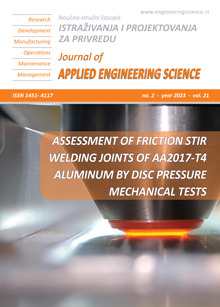ANALYSIS OF DOUBLE RESISTANCE SPOT WELDING'S FAILURE IN HIGH STRENGTH LOW ALLOY STEEL
Abstract
High strength low alloy steel (HSLA DOCOL 500 LA) is utilized in the automotive structure because of its superior qualities such as good fatigue resistance, a high strength-to-weight ratio, assisting in reducing the weight of the vehicle, increasing fuel efficiency and lower CO2 emissions. Resistance Spot Welding (RSW) is the most welding technique that is used to join automobile parts together. This study investigated the RSW process for high-strength steel. By utilizing the Taguchi approach, the optimization process for double spot nuggets with the principal welding parameters of welding current, welding time, and electrode force was carried out. The values of optimum parameters were 8800Amp for welding current, welding time of 30 cycles and 2560 N for electrode force. Mechanical and microstructure tests were carried out to study the failure modes while the fatigue test was achieved to obtain the fatigue endurance limit and it was at a maximum load 1500 N and during the fatigue test two types of failure happened: full pull-out failure and cracks around the nugget zone.
References
Zhang, W., Yang, S., Lin, Z., Wu, T. (2020). Weld morphology and mechanical properties in laser spot welding of quenching and partitioning 980 steel. Journal of Manufacturing Processes, vol.56, 1136-1145, DOI: 10.1016/j.jmapro.2020.05.057
Yang, Y.P., Gould, J., Peterson, W., Orth, F., Zelenak, P., Al-Fakir, W. (2013). Development of spot weld failure parameters for full vehicle crash modelling. Science and Technology of Welding and Joining.vol.18, no.3,222–231, DOI: 10.1179/1362171812Y.0000000082
Pouranvari, M., Sobhani, S., Goodarzi, F. (2018) Resistance spot welding of MS1200 martensitic advanced high strength steel: Microstructure-properties relationship. Journal of Manufacturing Processes, vol.31, 867-874, DOI: 10.1016/j.jmapro.2018.01.009
Li, Y.B., Li, D.L., Lin, Z.Q., David, S.A., Feng, Z., Tang, W. (2016). Review: magnetically assisted resistance spot welding. Science and Technology of Welding and Joining, vol.21, no.1,59–74, DOI:10.1179/1362171815Y.0000000059
Moshayedi, H., Sattari-Far, I. (2012). Numerical and experimental study of nugget size growth in resistance spot welding of austenitic stainless steels. Journal of Materials Processing Technology, vol.212, no.2, 347–354, DOI: 10.1016/j.jmatprotec.2011.09.004
Keeler S, (2015). Advanced high strength steels (AHSS) guidelines. Technical Report Version 4.1, World auto steel, World steel association.
R. Kuziak, R., Kawalla, R., Waegler,S. (2008). Advanced high strength steels for automotive industry. Archives of Civil and Mechanical Engineering, vol.8, no.2,103–117, DOI:10.1016/S1644-9665(12)60197-6
Murugan, S.P., Cheepu, M., Vijayan, V., Ji, C.,Park, Y.D, (2018).The resistance spot weldability of a stainless steel/aluminium/low carbon steel 3-ply clad sheet. Journal of Welding and Joining, vol.36, no.1, 25–33. DOI: 10.5781/JWJ.2018.36.1.3
Sadiq, S.E., Bakhyb,S.H., Jweeg, M.J.,( 2020).Effects of Spot Welding Parameters on the Shear Characteristics of Aluminum Honeycomb Core Sandwich Panels in Aircraft structure. Test engineering and management, vol. 83, 7244 – 7255.
Jweeg, M.J., Bakhy, S.H., Sadiq, S.E., (2021). Effects of Core Height, Cell Angle and Face Thickness on Vibration Behavior of Aircraft Sandwich Structure with Honeycomb Core: An Experimental and Numerical Investigations. Materials Science Forum, vol. 1039, 65-85, DOI: 10.4028/www.scientific.net/MSF.1039.65.
Fakhri, M. S., Al-Mukhtar, A. M., Mahmood, I. A. (2022). Comparative Study of the Mechanical Properties of Spot Welded Joints. Materials Science Forum, VOL. 1079, 21-28, DOI: 10.4028/p-488xsr.
Kim, D.C., Jo, H.G., Kim, Y.M., Kang, M.J., Hwang, I., (2020). Effects of electrode face thickness on resistance spot weldability of aluminum alloy 6061. Journal of Welding and Joining, vol.38, no.1, 67–72,DOI: 10.5781/JWJ.2020.38.1.7
Khodabakhshi, F., Kazeminezhad ,M., Kokabi, A.H., (2014) .On the failure behavior of highly cold worked low carbon steel resistance spot welds. Metallurgical and Materials Transactions A, vol.45, no. 3, 1376–1389, DOI: 10.1007/s11661-013-2074-3
Badkoobeh, F., Nouri, A., Hassannejad, H., Mostaan, H., (2020). Microstructure and mechanical properties of resistance spot welded dual-phase steels with various silicon contents. Materials Science and Engineering, vol.790, DOI: 10.1016/j.msea.2020.139703
Sheikhi, M., Jaderian, S., Mazaheri, Y., Pouranvari, M., (2020). Prediction of the failure mode of automotive steels resistance spot welds. Science and Technology of Welding and Joining, vol.25, no. 6, 511–517, DOI:10.1080/13621718.2020.1747765
Chen, R., Zhang, C., Lou, M., Li, Y., Carlson, B.E., (2020). Effect of Al- Si coating on Weldability of press-hardened steels. Journal of Materials Engineering and Performance, vol.29, no.1, 626–636. DOI:10.1007/s11665-020-04555-w.
Shandook, A.A., Hassan, S.S., (2021). An Investigation of Microwave Furnace Effects on Mechanical Properties of Standard Specimens used in Tensile and Fatigue Tests due to different type of Manufacturing. Journal of Mechanical Engineering Research and Developments, vol. 44, no. 3,111-121.
Abbass, M.K., Ataiwi, A.H., Ameed, A., (2014). Study Fatigue Behavior of Friction Stir Welded Joints for Dissimilar Aluminum Alloys (2024 -T3 and 7020 -T6). Engineering and Technology Journal, vol.32, no.2, 439-452, DOI: 10.30684/etj.32.2A.11.
Rajarajan, C., Sivaraj, P., Sonar, T., Raja,S., Mathiazhagan,N., (2022).Resistance spot welding of advanced high strength steel for fabrication of thin-walled automotive structural frames. Forces in Mechanics, vol. 7, DOI:10.1016/j.finmec.2022.100084
Tian, J., Tao, W., Yang, S., (2022). Investigation on microhardness and fatigue life in spot welding of quenching and partitioning 1180 steel. journal of materials research and technology, vol.19, 3145-3159,DOI:10.1016/j.jmrt.2022.06.083
Hussein, S.K., Barrak. O.S., (2016). Optimization the Resistance Spot Welding Parameters of Austenitic Stainless Steel and Aluminum Alloy Using Design of Experiment Method. Engineering and Technology Journal, vol.34, no.7, 1383-1401, DOI: 10.30684/etj.34.7A.11
Kimchi,M., Phillips, D.H,(2017).Resistance Spot Welding Fundamentals and Applications for the Automotive Industry. Morgan & Claypool publishers, USA.
Minitab 19 Statistical Software (2020). [Computer software], (www.minitab.com)
Pouranvari, M., Marashi, S.P.H., (2013). Critical review of automotive steels spot welding: process, structure and properties. Science and Technology of Welding and Joining, vol.18, no.5, 361-403, DOI: 10.1179/1362171813Y.0000000120
Batista, M., Furlanetto, V., Brandi, S. D, (2020). Development of a Resistance Spot Welding Process Using Additive Manufacturing. Metals, vol.10, DOI:10.3390/met10050555

